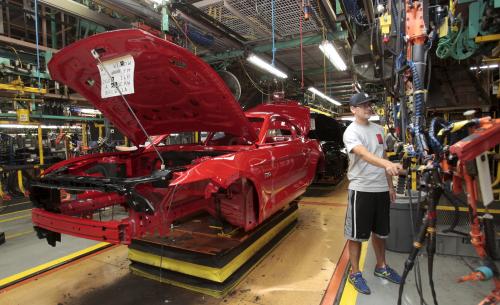All year, the Metro Program has been documenting the nation’s prosperity divides, ranging from the tech divide to the productivity divide to the output divide. Over and over, the stark unevenness of the nation’s city and regional economic map reads like a Rosetta stone of the nation’s frustration.
But now let’s talk about another gap: the city size gap. City size matters because it’s a major influence on city prosperity and adaptability as well as local worker fortunes. Bigger cities are more productive. They are more innovative. They draw better-educated workers by offering higher wages.
And yet here’s what may matter most in an era of disruptions: whether they rely on local retail activity or coal mines, or a hospital or auto parts plant, small metropolitan areas are having a hard time adapting to recent technology transitions that seem to favor large urban concentrations that vastly increase the returns to proximity.
This was the point Eduardo Porter of The New York Times made in a sobering essay last week based on some of our data. As Porter wrote, the struggles of smaller places to recover from shocks and adapt to change are again looking like a huge problem for a widely dispersed country contending with an era of “winner take all (or most)” economies and the big getting bigger. See, for example, in the table below the extent to which larger metropolitan areas have recovered significantly better than smaller ones from the Great Recession, as reflected by three basic measures of labor market performance.
|
Labor market performance by metro size tier 2009-2015 |
|||
| Metro group | Private employment CAGR | Real personal income CAGR | Labor force participation rate change |
| Top 20 (n = 20) | 1.9% | 2.1% | -0.1% |
| Large metros (n = 100) | 1.8% | 1.9% | -0.3% |
| Medium metros (n = 100) | 1.2% | 1.6% | -0.8% |
| Small metros (n = 182) | 1.1% | 1.6% | -1.0% |
| All metros (n = 382) | 1.7% | 1.9% | -0.4% |
| United States | 1.6% | 1.8% | -0.6% |
|
Notes: Averages weighted by private employment (total employment minus the public sector); large metros are those in the national top 100, medium metros are the next 100, and small metros are the smallest 182; labor force participation includes workers aged 20-64 and is drawn from 2005-09 and 2011-15 American Community Survey 5-year estimatesSource: Brookings analysis of Moody’s Analytics, U.S. Census, and BEA data |
|||
In this vein, it is becoming clear from research such as by Kelly Ray Wilkin that labor market adjustment (so important to regional adaptability) is yet another area of large-city superiority that puts small cities and regions at a disadvantage. In this regard, where small places afford workers relatively few nearby or diverse options for finding new work, the larger and denser labor markets of big cities afford workers vastly more job opportunities and therefore ways to achieve to achieve new jobs and higher earnings following unemployment. From that perspective, the relatively weak ability of so many small places to support the successful adjustment of workers and firms to economic shocks and new trends portends a future of pain for a lot of people and places. Millions of people may be stuck. That’s a problem. If a critical function of the city in an age of disruption is to ameliorate under- and un-employment by facilitating workers’ search for new employment, small cities and regions and the people in them are at a disadvantage.
What’s driving the rise of the big and the decline of the small are the powerful, ubiquitous forces of agglomeration amplified by technology
What should be done about the plight of the small places increasingly being left behind? Our colleague Amy Liu and ourselves acknowledged recently that it’s a wickedly hard problem to which economists have as yet detailed few solutions. After all, what’s driving the rise of the big and the decline of the small are the powerful, ubiquitous forces of agglomeration amplified by technology, which are powering growth and more growth in large metropolises at the expense of the drift of smaller, less educated, and techy places.
And yet, one doesn’t have to be naïve or overly idealistic to think that the nation can and must do better than simply helping the residents of small-city America move to a big city, as Porter recommends in concluding his piece. Supporting progress towards “catch up” among the more vibrant of smaller places, especially by investing in their higher education institutions and digital skills, is one of the dozen ways Amy and I proposed to help some smaller places advance. Likewise, the centrality to cities’ value of their ability to support worker adjustment argues for bold federal and state reforms of the nation’s current threadbare adjustment programs, with an eye to their effectiveness in small places.
In any event, one doesn’t have to believe we should save every place left behind to think we need to help at least some catch up even as the waves of disruption sweep through nearly every field and workplace.







Commentary
Big cities, small cities—and the gaps
October 17, 2017